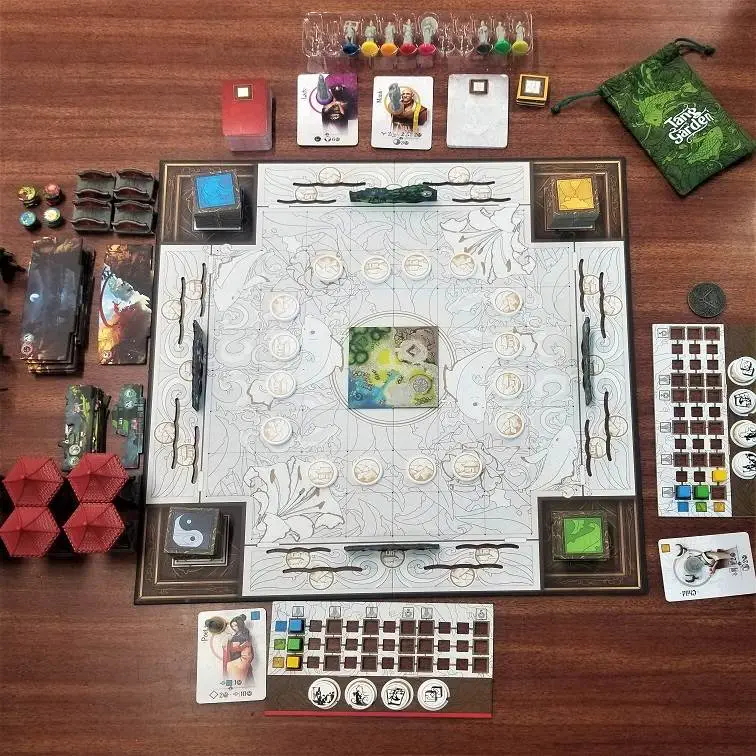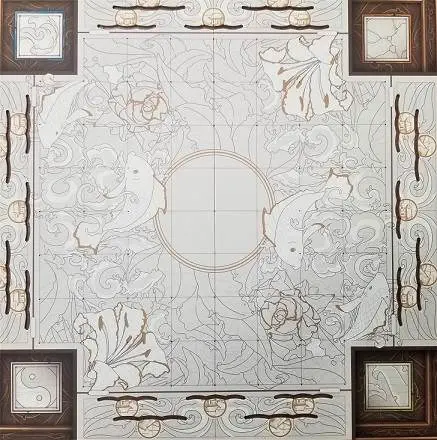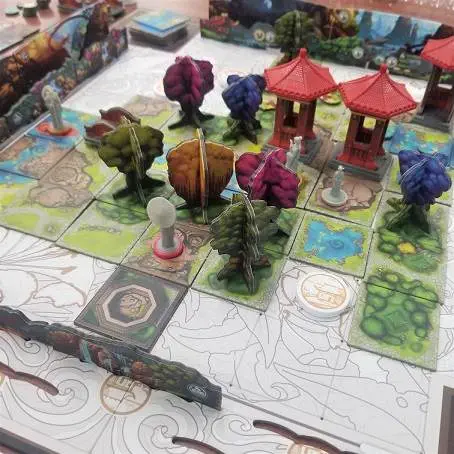
Known as a golden age for Chinese arts and culture, the T’ang Dynasty brought about many magnificent advancements for China. During this time, literature blossomed and became more accessible to the masses with new technologies; rigid policies from previous dynasties were relaxed or abolished entirely; crucial advancements in medicine were developed and practiced; and many in the upper class were able to reserve time for outdoor activities and sports for leisure. It was also when Emperor Xuanzong commissioned various engineers to build and create the Garden of the Majestic Clear Lake – one of the first classical Chinese gardens of its time – for his beloved concubine, Yang Guifei. Tang Garden from Thundergryph Games transports players back to ancient Xi’an to take on the role of said engineers as they construct this zen-filled oasis.
Designed by Francesco Testini and Pierluca Zizzi, Tang Garden is nothing if not gorgeous. Artist Matthew Mizak brings vibrant colors and imagery together, allowing players to create something akin to a piece of art each game. As the game progresses, a vivid panorama develops almost as if being painted across a canvas. The board almost resembles such a canvas when the game begins. There is little initial color to make it stand out, but the space is quickly filled in with landscapes, flora, and fauna to create a multicolored masterpiece. 2D and 3D elements combine over the course of the game to portray a garden unlike any other. These aspects were very noticeable to us, and we genuinely appreciate games that take the extra effort to be so visually appealing.

With such an aesthetic masterpiece before us, the next question, of course, is “how does it play?” Once set up, the player who most recently visited China (or a randomly chosen player) goes first. On their turn, players have the choice of placing a tile to expand the garden or decorating it. If choosing to build the garden, players will pick one of the face-up element tiles to situate on the board by matching the edges of any connecting tiles. Making these matches will earn players various rewards depending on what tiles are placed and where. Should a tile cover a landscape token, the player will get to choose from the available large or small landscapes of appropriate size as dictated by the token and place it on the board in a matching slot of their choosing. When decorating, the player will draw cards from the decoration deck equal to 2 plus the number of landscape tile stacks that have not yet been refreshed. From these cards, the active engineer will choose one to use and discard the rest. Decoration cards will dictate where the item can be placed as well as any information regarding point values, set requirements, or other additional rewards. It should be noted that it is possible to draw no cards that would allow for the legal placement of a decoration. Should this happen, the player must discard all drawn cards and forfeit their turn. Additionally, players may use a lantern from their player board once per turn for a specific bonus action, influence a character if they have reached the required level on their board, or refresh a lantern by spending 4 previously collected landscape tokens. These choices will continue from player to player until there are either 3 or fewer landscape tokens left on the board or any of the tile stacks have been depleted at the end of a turn. This triggers the end game and any players who have not had a turn this round will have a final chance to add to the garden.
The game is one of the best instances of point salad we have seen in a while. Coins will be earned throughout the game and are worth a point each. Decorations you have placed are worth points based on several factors including set collection and what is around them. Characters that have been placed in the garden will score more points for what they can see based on the quantity of visuals as well as personal preferences. All of these are added together for a final total and, as expected, the player with the highest number of points will be declared the winner and earn the Emperor’s favor for their engineering effort in the garden. To truly succeed, players need to balance their choices (which elements they play, player powers/end game scoring needs for characters, when is the optimal time to decorate, and when to trigger vs prolong the end of the game).
With so much going for it, we do feel we should mention the few issues we found with Tang Garden. In 2 player games, it is really easy to fill the whole player board for both players without triggering the end of the game. Some of the scenarios included in the expansions alleviate this, but the base game and normal play do not and we found ourselves with full boards and quite a few options left for continued play. Also of note when considering expansions, Ghost Stories is nearly unplayable without some of the components from the Golden Age expansion unless players create their own scenarios. This is especially something to consider when grabbing boxes to take to game night. Likewise, there is a meta based on which expansions are included in your session. Knowing what characters are available and what they all do can be a bit daunting for new players, yet is not so heavy as to take away from the experience of new players. This can easily be overcome by playing a few games, however. None of these issues are enough to sway us away from our praises of Tang Garden, but we did feel they were worth bringing up.
As mentioned above, “crafting” one’s own scenarios is possible. The rulebooks give players pointers on what to do and what to avoid when doing so, which we found incredibly helpful and made for a much smoother experience. With the inclusion of these homebrew scenarios as well as those in Tang Garden: Golden Age, Tang Garden: Ghost Stories, and the upcoming Tang Garden: Seasons, there is quite a bit of extra replayability and modes of play on top of what already comes in the main box. This was one of the main selling points for us during both Kickstarter campaigns and we have been very happy with just how much game you really do get for your purchase. If you found our review helpful, please let us know, and, as always, we look forward to hearing about your experience with Tang Garden!
All photos used in this review were taken and edited by Krista.

